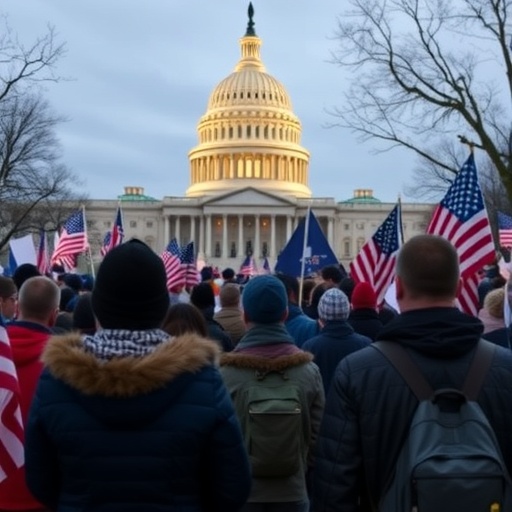U.S. Government shutdown Reaches Day 21: Federal Workers Suffer as Congress Deadlocks Over Funding
In a stark display of political gridlock, the U.S. federal Government shutdown has dragged into its 21st day, leaving over 800,000 federal workers furloughed without pay and essential services teetering on the brink of collapse. As Republicans and Democrats in Congress dig in their heels, the economic ripple effects are mounting, with small businesses feeling the pinch and families across the nation bracing for uncertainty. This prolonged standoff, sparked by disputes over border security funding, threatens to become the longest shutdown in modern history, surpassing the 1995-1996 record of 21 days.
The shutdown, now in its third week, has frozen non-essential government operations, from national parks to regulatory agencies. Federal workers, many of whom live paycheck to paycheck, are resorting to food banks and credit cards just to make ends meet. “It’s heartbreaking to see dedicated public servants sidelined like this,” said Sen. Elizabeth Warren (D-MA) in a recent floor speech, highlighting the human cost of the impasse.
Federal Workers Face Mounting Financial Hardships
The human toll of the Government shutdown is perhaps most acutely felt among the hundreds of thousands of federal workers thrust into limbo. According to the Office of Personnel Management, approximately 800,000 civilian federal employees are either furloughed or working without pay, a figure that doesn’t even include the 1.3 million active-duty military personnel exempted from cuts but still facing delayed support services.
Take, for instance, Maria Gonzalez, a 45-year-old administrative assistant at the Environmental Protection Agency (EPA) in Washington, D.C. With two kids in college and a mortgage to pay, Gonzalez has been dipping into her savings since December 22, when the shutdown began. “I’ve never missed a paycheck in 15 years of service,” she told reporters outside the Capitol last week, her voice cracking with frustration. “Now, I’m wondering if we’ll lose our home.” Stories like Gonzalez’s are echoing across the country, from IRS auditors in Atlanta to USDA inspectors in rural Kansas.
Statistics paint a grim picture: A recent survey by the National Treasury Employees Union revealed that 70% of affected federal workers have less than $1,000 in emergency savings, forcing many to seek unemployment benefits or side gigs. In Virginia alone, where federal jobs are a economic lifeline, local food pantries report a 40% uptick in demand since the shutdown started. Economists estimate that the shutdown is costing the U.S. economy up to $1.4 billion per week in lost productivity, with federal workers bearing the brunt.
Beyond immediate financial strain, the psychological impact is profound. Mental health experts warn of rising stress levels, with hotlines like the National Alliance on Mental Illness noting increased calls from government employees. “This isn’t just about money; it’s about dignity and stability,” said Dr. Elena Ramirez, a psychologist specializing in workplace trauma. As the shutdown persists, federal workers are left in a state of limbo, promised back pay once resolved but uncertain when that day will come.
Partisan Divide Deepens: Republicans and Democrats Clash on Border Funding
At the heart of the government shutdown lies a bitter partisan divide in Congress, where Republicans demand robust funding for border wall construction as a non-negotiable condition for reopening the government, while Democrats insist on protections for Dreamers and comprehensive immigration reform. House Speaker Nancy Pelosi (D-CA) has repeatedly blocked votes on funding bills that include wall allocations, calling them “a waste of taxpayer dollars.”
On the Republican side, President Donald Trump has taken a hardline stance, tweeting last Thursday, “Democrats are holding the government hostage over open borders. We will not yield!” Senate Majority Leader Mitch McConnell (R-KY) echoed this sentiment, vowing to hold the line until Democrats compromise. Negotiations in the Senate have stalled, with a proposed bipartisan deal collapsing last week after Republicans added $5.7 billion for the wall—a figure Trump insists is essential for national security.
Key sticking points include not just the wall funding but also disaster relief for hurricane-hit states and farm aid amid the ongoing trade war with China. “This shutdown is self-inflicted by extreme positions on both sides,” noted Rep. Will Hurd (R-TX), one of the few bipartisan voices urging compromise. Hurd, representing a border district, warned that prolonged deadlock could alienate moderate voters ahead of the 2020 elections.
Behind closed doors, sources say frustration is boiling over. A Democratic aide revealed that private talks between Pelosi and Trump yielded no progress, with the president reportedly hanging up on a call after five minutes. Meanwhile, Senate Minority Leader Chuck Schumer (D-NY) has accused Republicans of playing politics with people’s livelihoods, stating, “Families shouldn’t suffer because of one man’s vanity project.” As the clock ticks, the risk of escalation grows, with some Republicans floating the idea of a debt ceiling showdown if the shutdown isn’t resolved soon.
Essential Services Grind to a Halt Nationwide
The government shutdown’s disruptions extend far beyond Capitol Hill, rippling into everyday American life through halted federal services. National parks, once bustling with holiday visitors, now stand eerily empty, patrolled by a skeleton crew of volunteers. Yosemite National Park, for example, has seen its gates barred, costing the local economy an estimated $500,000 daily in lost tourism revenue.
Air travel is another casualty: The Federal Aviation Administration (FAA) is operating at reduced capacity, leading to flight delays at major airports. Over the weekend, more than 10,000 flights were delayed due to unpaid air traffic controllers calling in sick from exhaustion. “We’re doing our best with half the staff,” said one anonymous controller at Chicago’s O’Hare International Airport.
Food safety inspections have also been curtailed, with the Food and Drug Administration (FDA) pausing routine checks on imported seafood and produce. This has raised alarms among grocers and consumers, as a backlog of shipments piles up at ports. In a particularly concerning development, the Centers for Disease Control and Prevention (CDC) has delayed flu vaccine distribution to some states, potentially exacerbating the ongoing outbreak that has already claimed over 6,000 lives this season.
Small businesses dependent on federal contracts are reeling too. In California, a tech firm supplying software to the Department of Defense reported laying off 50 employees after payments froze. “We’ve got invoices worth millions in limbo,” said CEO Raj Patel. The U.S. Chamber of Commerce estimates that 1 in 5 small businesses with government ties are at risk of closure if the shutdown lasts another week.
Even international relations feel the strain: Embassy staff reductions have slowed visa processing, stranding tourists and business travelers. As these disruptions compound, calls for emergency funding measures are growing, though Congress remains paralyzed.
Public Backlash Builds Against Prolonged Shutdown
Public opinion is shifting dramatically as the government shutdown wears on, with polls showing widespread frustration directed at both parties in Congress. A new Quinnipiac University survey indicates that 52% of Americans blame Republicans for the impasse, up from 45% a week ago, while 38% point to Democrats. Overall approval for how Congress is handling the crisis sits at a dismal 19%.
Protests have erupted in major cities, with federal workers and advocacy groups marching on the National Mall. In New York, a rally organized by the American Federation of Government Employees drew 5,000 participants chanting, “End the shutdown now!” Signs reading “Pay Our Workers” and “No Wall on Our Paychecks” dotted the crowd, underscoring the growing anger.
Social media is ablaze with personal stories, amplifying the emotional resonance of the crisis. Hashtags like #ShutdownStories have trended, featuring tales from Coast Guard families unable to afford holiday meals to Smithsonian curators worried about artifact preservation. Influential voices, including Oprah Winfrey, have weighed in, tweeting, “This is what happens when politics trumps people. Congress, do your job.”
Among independents, support for compromise is surging, with 68% favoring a clean funding bill without wall provisions, per a Pew Research poll. This backlash could have electoral implications, as vulnerable lawmakers in swing districts face constituent ire. For instance, Rep. Mikie Sherrill (D-NJ), a freshman, has introduced a bill to ensure back pay for federal workers, gaining bipartisan co-sponsors despite the deadlock.
As media coverage intensifies, the narrative of suffering federal workers is dominating headlines, pressuring holdouts to negotiate. Yet, with midterm gains still fresh, both Republicans and Democrats are wary of appearing weak, prolonging the stalemate.
Pathways to Resolution: Emergency Measures and Long-Term Reforms
Looking ahead, several potential pathways could end the government shutdown, though none seem imminent without significant concessions. Short-term, President Trump could invoke emergency powers under the National Emergencies Act to redirect funds for the wall, bypassing Congress—a move Democrats have vowed to challenge in court. Legal experts predict such an action would spark immediate lawsuits, potentially reaching the Supreme Court within months.
Bipartisan talks are slated to resume this week, with Senate moderates like Susan Collins (R-ME) and Joe Manchin (D-WV) pushing a compromise package that includes $1.6 billion for border security enhancements short of a full wall. “We need practical solutions, not symbols,” Collins said in an interview. If successful, this could reopen the government by week’s end, allowing federal workers to return and services to resume.
Longer-term, the crisis underscores the need for reforms to prevent future shutdowns. Proposals include automatic continuing resolutions to fund the government at prior levels until agreements are reached, or a balanced budget amendment to enforce fiscal discipline. The Bipartisan Policy Center advocates for a “shutdown insurance” fund to pay workers during lapses, drawing from past precedents like the 2013 debt ceiling deal.
Economists warn that if the shutdown extends beyond 25 days, it could shave 0.5% off GDP growth in the first quarter of 2019, exacerbating slowdown fears. International markets are watching closely, with the dollar weakening against the euro amid uncertainty. For federal workers, the wait continues, but glimmers of hope in backchannel negotiations suggest relief may be on the horizon. As one Capitol Hill veteran put it, “Deadlocks break when the pain becomes unbearable for all sides.” Until then, the nation holds its breath.









